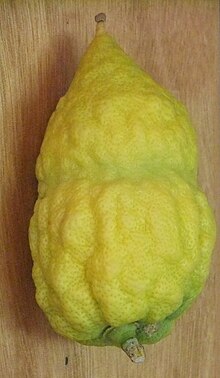Etrog
[5][6] A rare Aramaic form, eṯrungā (אֶתְרוּנְגָּא), is significant because it retains the alveolar nasal sound (as indicated by the nun) of wādrang, also observable in the English word 'orange'.
[10] The earliest evidence of etrogim in Israel is the 2012 discovery of citron pollen from the second century BCE in excavations at the Ramat Rachel site.
[11] After the fall of Jerusalem in 70 CE, exiled Jews planted citron orchards wherever the climate allowed: in Southern Europe (Spain, Greece, and Italy) as well as in North Africa and Asia Minor.
Jews who settled north of the warmer citron-growing areas depended on imported etrogim, which caused much anxiety given the dangers and uncertainties of sea travel.
[citation needed] Since the late 1850s, the Fruit of the Goodly Tree Association in Mandatory Palestine represented etrog farmers who marketed their crops to Jews in Europe.
The only commercial grower of etrogs in the United States is John Kirkpatrick, the former chairman of the Citrus Research Board, on a ranch in the town of Exeter in the San Joaquin Valley of California.
Kirkpatrick, who is not Jewish, began growing etrogs in 1980 following a phone call with Yisroel Weisberger, an employee at a Judaica store in Brooklyn.
[12] While there are other growers in California, such as Inga Dorosz and David Sleeth in the town of Gorda near Big Sur, these are not rabbinically supervised and are therefore not kosher.
Many more pitamim are preserved today due to an auxin discovered by Eliezer E. Goldschmidt, emeritus professor of horticulture at the Hebrew University.
While working with the picloram hormone in a citrus orchard, he unexpectedly discovered that some of the Valencia oranges found nearby had perfectly preserved pitamim.
Experimenting with picloram in a laboratory, Goldschmidt eventually found the correct "dose" to achieve the desired effect: one droplet[clarification needed] of the chemical in three million drops of water.
A general DNA study was conducted by Eliezer E. Goldschmidt and colleagues which tested and positively identified twelve famous accessions of citron for purity and being genetically related.
[20] To protect the etrog during the holiday, it is traditionally wrapped in silky flax fibers and stored in a special decorative box, often made from silver.



